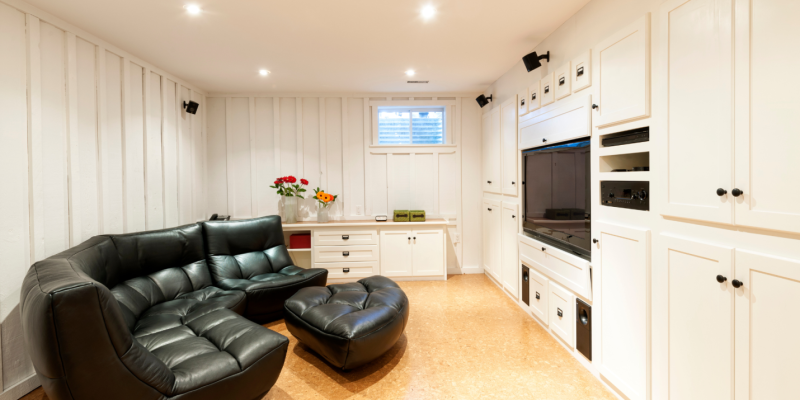An unfinished basement is full of untapped potential. Whether it’s being used as a storage space, laundry area, or simply left unused, it holds the opportunity to add value, function, and comfort to your home. Fortunately, you don’t need a massive budget to make a big impact. With a bit of planning, creativity, and the right priorities, you can transform your unfinished basement into a space you’ll actually enjoy—without breaking the bank.
Here are several budget-friendly tips to help you get started.
1. Start with a Clear Vision and Priorities
Before you begin any renovation, take time to define the purpose of the space. Will it be used as a guest suite, home office, entertainment zone, gym, or a mix of multiple functions? Setting a clear vision upfront helps prevent costly changes later. Once you know what you want, prioritize must-have features versus “nice-to-haves.” This will help you stay within budget and focus on essentials first.
2. Keep the Layout Simple
Basements can become costly when major structural changes or extensive plumbing work are involved. To keep costs low, try to work with the existing layout. Avoid relocating water lines or adding complex wall partitions if you can help it. Instead, use furniture, rugs, lighting, or room dividers to define separate zones within an open layout. Simplicity doesn’t mean boring—it just means smarter spending.
3. Focus on Flooring That’s Functional and Affordable
Basement floors are often concrete, which is durable but not particularly cozy. Instead of splurging on hardwood or tile, consider more budget-friendly options like vinyl plank flooring, laminate, or even painted concrete. Vinyl is moisture-resistant and comes in a variety of stylish finishes that mimic wood or stone. Area rugs can also add warmth and comfort without a permanent commitment or high price tag.
4. Paint Is Your Best Friend
One of the easiest and most affordable ways to refresh an unfinished basement is with paint. A coat of light, neutral-colored paint on the walls can make the space feel brighter and more inviting. If the basement ceiling is exposed, painting the beams and pipes in black, white, or a soft gray can give it an intentional industrial look without the cost of drywall installation. Don’t underestimate what a few gallons of paint can do!
5. Use Lighting Strategically
Basements often lack natural light, so choosing the right lighting setup is crucial. Recessed lighting is a popular choice, but it can be pricey to install. Instead, opt for cost-effective alternatives like floor lamps, wall sconces, or track lighting. Place lights strategically to brighten dark corners and make the space feel more open. Adding mirrors can also help reflect light and give the illusion of a larger, airier basement.
6. Insulate and Finish Walls on a Budget
Fully finishing your walls with drywall and insulation is a great long-term investment, but it doesn’t have to all happen at once. Consider starting with foam board insulation, which is easy to install yourself and provides an instant barrier against cold. For walls, you can use budget-friendly paneling or shiplap as a temporary or partial solution. If full finishing is out of budget, even hanging curtains or fabric panels can help disguise exposed walls and make the space more inviting.
7. Get Creative with Storage Solutions
An unfinished basement often turns into a dumping ground for seasonal decorations, tools, or old furniture. Rather than eliminating storage altogether, integrate it into your design. Install open shelving or use repurposed cabinets for a DIY storage wall. Labeled bins and baskets can keep clutter under control while still looking tidy. Built-in benches with hidden storage are also a smart and affordable solution for multipurpose use.
8. Know When to DIY—and When Not To
Tackling certain tasks yourself, such as painting, assembling furniture, or installing vinyl flooring, can save a significant amount of money. However, it’s important to know your limits. For structural work, electrical wiring, or plumbing, hiring a professional is not only safer—it can actually save you money in the long run by avoiding mistakes or code violations.
If you’re unsure where to start, connecting with a trusted basement remodeling contractor can help you explore budget-conscious options that align with your goals. Many contractors are open to working in phases or suggesting value-engineered solutions that still produce a high-quality finish.
Transforming an unfinished basement doesn’t require a luxury budget—it just requires a thoughtful approach, a bit of elbow grease, and a clear vision. By focusing on affordable materials, simple layouts, and gradual improvements, you can create a basement that adds comfort, functionality, and value to your home.
Whether you’re converting your basement into a cozy retreat, a productive workspace, or a family-friendly hangout, small updates can lead to big transformations. With careful planning and smart choices, your basement can go from forgotten to fantastic—without draining your wallet.

Comments